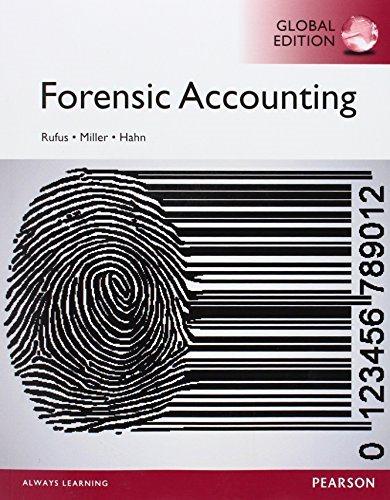12-85. Glen and Diane Flood owned and operated Floods Auto Parts and Glenwood Wrecker Service in Chatsworth,
Question:
12-85. Glen and Diane Flood owned and operated Flood’s Auto Parts and Glenwood Wrecker Service in Chatsworth, Georgia. The companies’ offerings to the local market included the sale of wholesale and retail auto parts, a wrecker service, and the sale of wrecked autos. Mr. Flood did not consistently prepare invoices for customers and had no other way to determine total sales for his businesses. Although Mr. Flood deposited some of the cash revenue into the company’s bank accounts, he stored some of it in a safe at his home.
Over several years, Mr. Flood purchased multiple businesses and sold all or parts of others. The terms of payment were not always recorded in written form, and not all of them were reported on Schedule C of Mr. Flood’s individual tax returns.
Through a routine examination of the company’s tax returns, an IRS examiner discovered that Mr. Flood had not reported all of the sales generated by his businesses.
Specifically, the examiner determined that Mr. Flood had understated taxable income for 1991, 1992, and 1993 by $28,195, $22,695, and $74,013, respectively.
The Floods challenged the IRS audit findings, specifically that: (1) Mr. Flood failed to maintain adequate books and records; (2) sales were routinely omitted from the recordkeeping process; (3) employees may have forgotten to record sales; (4) not all cash revenue was deposited in the bank; and (5) Mr. Flood was aware of these failures and chose to withhold this information from the tax preparer.
The tax court’s memorandum is available at www .ustaxcourt.gov. At the homepage of this site, select the “Opinions Search” tab. Then, use the case keywords feature and enter: “Flood.” A case with the name Glenn H. and Diane J. Flood will be among the cases listed. Select this case for further use.
After reading the case, respond to the following questions.
1. What method did the IRS examiner use to determine the amount of unreported income? Why did the IRS examiner select this as an appropriate method for this case?
2. Explain how the source and application of funds method works.
3. Using the data presented in the case, recreate in an Excel spreadsheet the source and application of funds worksheets for 1991, 1992, and 1993. Then provide an explanation of how each component of the spreadsheet contributes to the reconstruction of taxable income. In other words, explain the methodology employed by the IRS examiner.
4. In what specific area did the Floods disagree with the IRS examiner’s findings? If the Floods are correct, what impact would it have on the amounts calculated as unreported income? How did the tax court rule on this matter?
5. How did the tax court view the indirect methodology used by the IRS examiner to develop unreported income?
6. How did the tax court determine whether a loan from Mr. Flood to his father was in fact a loan that became worthless in 1992? How did the tax court rule?
7. The IRS examiner determined that a 20% accuracy penalty on the unreported amounts was appropriate. What was the basis for this determination?
How did the court rule, and why?
8. Why was this case tried in the U.S. Tax court rather than U.S. District court? What is the difference? Who decides?
Step by Step Answer:

Forensic Accounting
ISBN: 9781292059372
1st Global Edition
Authors: Robert J. Rufus, Bill Hahn, Laura Savory Miller, William Hahn





